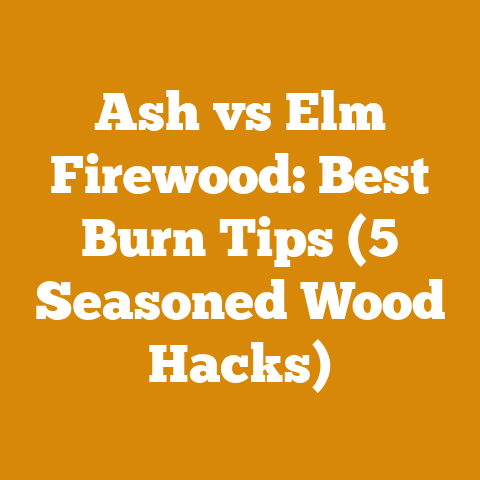Combination Gas and Wood Fireplace Insights (5 Pro Arborist Tips)
“Why won’t my gas fireplace warm up my house like a real wood fire?”
If I had a nickel for every time I’ve heard that complaint, well, let’s just say I could probably afford a whole lot more firewood. It’s a common frustration, and it stems from a misunderstanding of what a combination gas and wood fireplace is truly designed to do. As a pro arborist with years of experience felling trees, processing wood, and, yes, even troubleshooting the occasional fireplace issue, I’ve gained some insights I think you’ll find helpful.
We’re going to dive deep into the world of combination gas and wood fireplaces, focusing on how to maximize their efficiency and get the most enjoyment out of them. This isn’t just about getting a roaring fire; it’s about understanding the science behind combustion, the properties of wood, and how to safely and effectively manage your fireplace for years to come. I’ll share some pro arborist tips that often get overlooked, ensuring you’re not just burning fuel, but creating a warm, inviting, and efficient heat source.
Understanding the Combination Fireplace: More Than Meets the Eye
A combination gas and wood fireplace offers the allure of both convenience and traditional charm. The gas component provides instant ambiance and supplemental heat, while the wood-burning option delivers the crackling fire and authentic warmth that many homeowners crave. However, this versatility also introduces complexities that require a deeper understanding.
The Design Compromise
The very nature of a combination fireplace involves a design compromise. Unlike a dedicated wood-burning fireplace, which is optimized for maximum heat output and efficient draft, a combination unit must accommodate both gas and wood fuel sources. This often results in a less efficient combustion chamber for wood burning.
- Smaller Firebox: Combination units often have smaller fireboxes compared to traditional wood-burning fireplaces. This limits the amount of wood you can burn and, consequently, the potential heat output.
- Compromised Draft: The flue design in a combination fireplace may not be ideal for wood burning. A strong draft is crucial for efficient combustion and preventing smoke from entering the room. Gas fireplaces typically require less draft than wood-burning fireplaces, so the design may lean towards the gas requirements.
- Air Intake: The air intake system may not be optimized for wood burning, potentially leading to incomplete combustion and reduced heat output. Wood fires thrive on a plentiful supply of oxygen.
The Role of Gas vs. Wood
It’s essential to understand the intended roles of each fuel source in a combination fireplace.
- Gas: Primarily for convenience, supplemental heat, and ambiance. It’s ideal for quick, easy fires and maintaining a consistent temperature.
- Wood: For authentic fire experience, significant heat output (when burned efficiently), and the enjoyment of tending a real fire.
Knowing this distinction will help you manage your expectations and optimize your fireplace usage. Don’t expect the gas function to replicate the intense heat of a well-managed wood fire.
Pro Arborist Tip #1: Mastering the Art of Wood Selection
As an arborist, I can’t stress enough the importance of choosing the right wood. It’s not just about grabbing any log you can find. The type of wood you burn directly impacts heat output, burn time, and the amount of creosote buildup in your chimney.
Hardwood vs. Softwood: The Great Debate
The age-old question: hardwood or softwood? The answer is almost always hardwood for sustained heat output.
- Hardwoods: Denser woods like oak, maple, ash, and beech contain more energy per unit volume. They burn hotter, longer, and produce less smoke than softwoods. They are my go-to for those long winter nights.
- Softwoods: Pines, firs, spruces, and other evergreens are less dense and contain more resin. They burn quickly, produce more smoke, and can contribute to creosote buildup. While they can be used for kindling, I generally avoid using softwoods as my primary fuel source in a fireplace.
Data Point: Oak has a heat value of approximately 27 million BTU per cord, while pine has a heat value of around 20 million BTU per cord. That’s a significant difference!
The Importance of Seasoning: The Key to Efficient Burning
Seasoning wood is the process of drying it to reduce its moisture content. Freshly cut (“green”) wood can contain up to 50% moisture by weight. Burning green wood is incredibly inefficient. A significant portion of the fire’s energy is used to evaporate the water, resulting in:
- Reduced Heat Output: Less energy is available to heat your home.
- Increased Smoke: Water vapor cools the combustion process, leading to incomplete combustion and more smoke.
- Creosote Buildup: Smoke contains unburned gases and particles that condense in the chimney, forming creosote. Creosote is highly flammable and can cause chimney fires.
Rule of Thumb: Aim for a moisture content of 20% or less for optimal burning.
How to Season Wood:
- Split the Wood: Splitting exposes more surface area, accelerating the drying process.
- Stack Properly: Stack the wood in a single row, elevated off the ground, with gaps between the pieces to allow for air circulation.
- Location Matters: Choose a sunny, well-ventilated location.
- Time is Your Friend: Allow the wood to season for at least six months, preferably a year or more.
Personal Story: I once tried to burn some oak that I thought was seasoned, but it turned out to be only partially dry. The fire was sluggish, smoky, and hardly produced any heat.
Identifying Well-Seasoned Wood
- Weight: Seasoned wood is noticeably lighter than green wood.
- Cracks: Look for cracks on the ends of the logs.
- Color: Seasoned wood is often darker in color.
- Sound: When you strike two pieces of seasoned wood together, they should produce a hollow sound.
- Moisture Meter: For the most accurate assessment, use a moisture meter. These devices are relatively inexpensive and can provide a precise reading of the wood’s moisture content.
Pro Arborist Tip #2: Optimizing Firewood Size and Placement
The size and arrangement of your firewood within the firebox significantly impact combustion efficiency. It’s not just about throwing logs in and hoping for the best.
The Right Size Matters
- Too Large: Large logs can smolder and produce excessive smoke. They also take longer to ignite fully.
- Too Small: Small pieces burn quickly and require frequent refueling.
- Ideal Size: Aim for pieces that are approximately 4-6 inches in diameter. The length should be slightly shorter than the width of your firebox.
Why this Matters: Properly sized wood allows for optimal airflow around the logs, promoting complete combustion and maximizing heat output.
The Art of Stacking: Building an Efficient Fire
The way you stack your firewood is crucial for creating a hot, clean-burning fire.
- Teepee Method: This is a classic method that’s ideal for starting a fire. Arrange small pieces of kindling and small logs in a teepee shape. This allows for excellent airflow and quick ignition.
- Log Cabin Method: Build a square or rectangular “cabin” with larger logs. Place kindling and smaller pieces in the center. This method provides a stable structure and allows for sustained burning.
- Top-Down Method: This method is gaining popularity for its clean-burning properties. Place larger logs on the bottom, followed by smaller pieces, and then kindling on top. Light the kindling from the top. As the fire burns down, it efficiently combusts the gases released from the wood below.
My Preferred Method: I personally prefer a modified log cabin method. I start with two larger logs on the bottom, spaced slightly apart. Then, I build a smaller log cabin on top of those, using progressively smaller pieces. I place kindling in the center and light it. This provides a good balance of airflow, stability, and sustained burning.
Diagram: (Imagine a simple diagram here showing the log cabin method with kindling in the center)
Airflow is Key
Regardless of the stacking method you choose, ensure there is adequate airflow around the logs. This is essential for complete combustion. Avoid packing the firebox too tightly.
Pro Arborist Tip #3: Mastering Air Control for Efficient Combustion
Most combination fireplaces have air controls that allow you to adjust the amount of air entering the firebox. Understanding how to use these controls is crucial for efficient combustion and maximizing heat output.
Understanding Airflow and Combustion
- Primary Air: This is the main source of air for combustion. It’s typically controlled by a damper or lever located near the bottom of the fireplace.
- Secondary Air: Some fireplaces have a secondary air supply that introduces air higher up in the firebox. This helps to burn the gases released from the wood, reducing smoke and increasing efficiency.
How Airflow Affects Combustion:
- Too Much Air: Can cool the firebox, reducing efficiency and increasing creosote buildup.
- Too Little Air: Leads to incomplete combustion, producing excessive smoke and reducing heat output.
Finding the Sweet Spot
The ideal airflow setting will vary depending on the type of wood you’re burning, the size of the fire, and the design of your fireplace. Experiment to find the sweet spot where you get a clean-burning fire with minimal smoke.
General Guidelines:
- Starting the Fire: Open the air controls fully to provide plenty of air for ignition.
- Sustained Burning: Once the fire is established, gradually reduce the air supply until you achieve a clean, hot burn.
- Monitor the Smoke: If you see excessive smoke, increase the air supply.
Personal Tip: I often start with the air controls fully open and then gradually close them down until I see the flames dancing actively and the smoke disappearing. It’s a bit of an art, but with practice, you’ll get the hang of it.
The Importance of a Clean Chimney
A clean chimney is essential for proper draft and efficient combustion. Creosote buildup restricts airflow and can pose a serious fire hazard.
- Annual Inspection: Have your chimney inspected by a qualified professional at least once a year.
- Regular Cleaning: Clean your chimney regularly to remove creosote buildup. The frequency of cleaning will depend on how often you use your fireplace and the type of wood you burn.
- DIY Cleaning: If you’re comfortable doing it yourself, you can purchase a chimney cleaning kit and follow the instructions carefully. However, I always recommend having a professional do it for safety reasons.
Data Point: The National Fire Protection Association (NFPA) estimates that chimney fires cause thousands of residential fires each year, resulting in millions of dollars in property damage.
Pro Arborist Tip #4: The Wood-Gas Dance: Coordinating Fuels for Optimal Performance
Think of your combination fireplace as a duet. You need to understand how the “wood” and “gas” voices harmonize to get the best performance. This isn’t about choosing one over the other, but understanding when and how to use each fuel source effectively.
Gas as a Starter: The Quick Ignition Advantage
Gas is fantastic for quick starts. Instead of fussing with kindling and newspapers, a gas starter gets the fire going rapidly, especially useful on chilly mornings when time is short.
- Speed and Convenience: Ideal for those who want instant flame without the prep work.
- Supplemental Heat: Provides a boost of warmth while the wood gets going.
How to Use It: Light the gas starter and place a small amount of kindling and small logs around it. Once the wood is burning well, turn off the gas.
Wood for Sustained Heat: The Long-Term Champion
Once the wood is burning strongly, it takes over as the primary heat source. This is where seasoned hardwoods shine, providing long-lasting, radiant heat.
- Radiant Heat: Wood fires produce radiant heat, which warms objects in the room directly, rather than just heating the air.
- Aesthetic Appeal: The crackling flames and cozy ambiance of a wood fire are unmatched.
The Hybrid Approach: Blending Gas and Wood
Some people use a combination of gas and wood throughout the entire burn. They might use the gas to supplement the wood fire, maintaining a consistent temperature or providing extra heat on particularly cold days.
My Recommendation: While this approach can be convenient, I generally prefer to use gas only for starting the fire and then rely on wood for sustained heat. This maximizes the efficiency of the wood and reduces the overall gas consumption.
Safety First: Gas Leak Detection
Gas leaks are a serious concern.
- Smell Test: Regularly check for the distinctive odor of natural gas or propane.
- Soap Test: Apply a soapy water solution to gas connections. If bubbles form, there’s a leak.
- Carbon Monoxide Detectors: Install carbon monoxide detectors near the fireplace and in sleeping areas.
Actionable Advice: If you suspect a gas leak, immediately turn off the gas supply, evacuate the house, and call your gas company or a qualified technician.
Pro Arborist Tip #5: Long-Term Maintenance and Safety: Protecting Your Investment
A combination fireplace is an investment, and like any investment, it requires proper maintenance to ensure its longevity and safety. As an arborist, I’m used to thinking long-term, and that’s the approach you should take with your fireplace.
Annual Inspections: The Foundation of Safety
As I mentioned before, annual chimney inspections are crucial. A qualified chimney sweep can identify potential problems, such as creosote buildup, cracks in the flue, or obstructions.
What to Expect During an Inspection:
- Visual Inspection: The sweep will visually inspect the chimney, firebox, and flue for any signs of damage or deterioration.
- Creosote Measurement: They will measure the thickness of the creosote buildup.
- Draft Test: They will perform a draft test to ensure the chimney is drawing properly.
- Report and Recommendations: They will provide you with a report outlining their findings and recommendations for any necessary repairs or cleaning.
Cleaning Frequency: Tailored to Your Usage
The frequency of chimney cleaning depends on several factors:
- How Often You Use the Fireplace: More frequent use means more frequent cleaning.
- Type of Wood You Burn: Softwoods and unseasoned wood produce more creosote.
- Burning Habits: Slow-burning fires and smoldering fires produce more creosote.
General Guidelines:
- Heavy Use (3+ times per week): Clean annually.
- Moderate Use (1-2 times per week): Clean every 1-2 years.
- Light Use (Less than once a week): Clean every 2-3 years.
Personal Anecdote: I had a friend who neglected his chimney for years. He burned mostly softwood and never had it cleaned. One day, he had a chimney fire that caused significant damage to his home. It was a costly and frightening experience that could have been easily avoided with regular maintenance.
Fire Safety Practices: Protecting Your Home and Family
- Keep Flammable Materials Away: Keep curtains, furniture, and other flammable materials at least three feet away from the fireplace.
- Use a Fireplace Screen: A fireplace screen prevents sparks and embers from escaping the firebox.
- Never Leave a Fire Unattended: Extinguish the fire completely before leaving the house or going to bed.
- Proper Ash Disposal: Dispose of ashes in a metal container with a tight-fitting lid. Store the container away from flammable materials.
- Smoke Detectors: Ensure you have working smoke detectors on every level of your home.
Addressing Common Problems
- Smoke Entering the Room: This could be due to a weak draft, a blocked chimney, or negative air pressure in the house. Try opening a window slightly to equalize the pressure.
- Poor Heat Output: This could be due to unseasoned wood, improper airflow, or a dirty chimney.
- Excessive Creosote Buildup: This is usually caused by burning softwoods or unseasoned wood.
Troubleshooting Tip: If you’re experiencing persistent problems with your fireplace, consult with a qualified chimney sweep or fireplace technician.
Beyond the Fireplace: Woodlot Management for Sustainability
As an arborist, I believe in sustainable woodlot management. If you have access to a woodlot, consider these practices:
- Selective Harvesting: Harvest mature or diseased trees, leaving younger trees to grow.
- Planting New Trees: Replenish the woodlot by planting new trees.
- Proper Seasoning: Season your firewood properly to reduce smoke and creosote.
By following these practices, you can ensure a sustainable supply of firewood for years to come.
Conclusion: Embrace the Art and Science of Fire
A combination gas and wood fireplace offers a unique blend of convenience and tradition. By understanding the principles of combustion, the properties of wood, and the proper maintenance techniques, you can maximize the efficiency and enjoyment of your fireplace.
Remember these key takeaways:
- Choose the Right Wood: Seasoned hardwoods are the key to efficient burning.
- Optimize Firewood Size and Placement: Properly sized and stacked wood promotes complete combustion.
- Master Air Control: Adjust the air supply to achieve a clean, hot burn.
- Coordinate Fuels: Use gas for quick starts and wood for sustained heat.
- Maintain Your Fireplace: Regular inspections and cleaning are essential for safety and longevity.
Burning wood is more than just a way to heat your home; it’s an art and a science. Embrace the process, learn from your experiences, and enjoy the warmth and ambiance of a well-managed fire. With these pro arborist tips, you’ll be well on your way to mastering the art of fire and creating a cozy and inviting home for years to come. Now, go forth and create some warmth!






